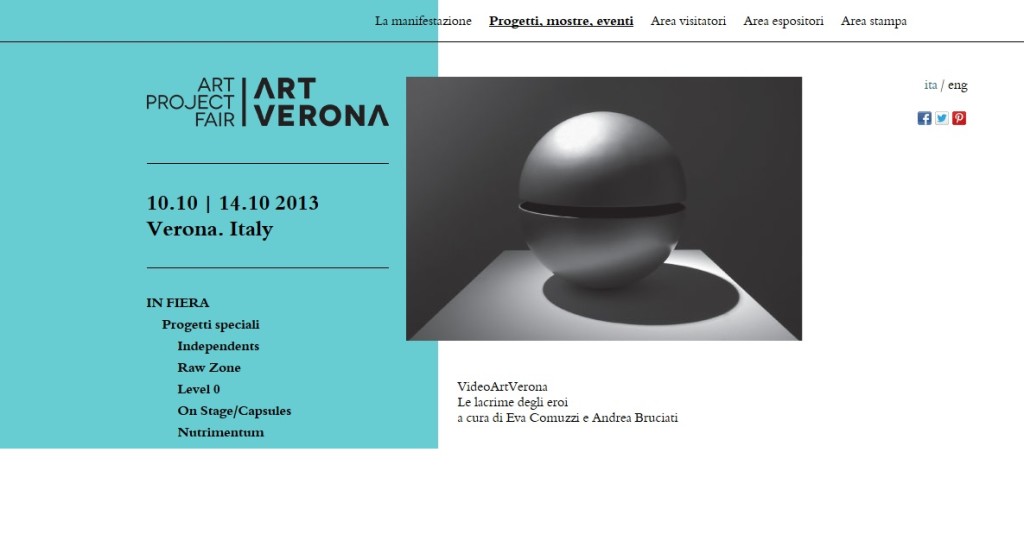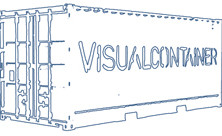VideoArtVerona
Tears of the heroes
by Eva Comuzzi and Andrea Bruciati
27 September to 30 October 2013
Audiovisual Centre of Verona | Library – Headquarter of Video Art Veneto Regional Archive
November 20 to December 14, 2013
[ . BOX] Video Art Project space – Via Federico Confalonieri 11, Milan
The tears of heroes, is the video review , by Eva Comuzzi and Andrea Bruciati , made expressly for the 2013 edition of VideoArtVerona , side-event of Art Verona .
The project, which investigates the performative language in its most innovative , starts with Different Pulses , Festival of Arts intangible , created by Eva Comuzzi in Cividale del Friuli in the month of July, to expand further to the venue Scala , declining further work selected in order to conceive a different idea of sculpture, almost liquid , where is the body to become an integral part.
With this goal in the exhibition will be presented in a series of works by Italian movement that document the progress of performative acts in a broad sense , where it is always a renewed perception of the plastic body to be the focus of the investigation.
How to reiterate the curators : ” All of us are becoming the show to ourselves : we conceive ourselves as actors in a global platform , and if we do not participate we feel excluded . We are so accustomed to the idea that everything is representation that the bodily experience , together with all the senses, is weakened . In this capacity, it is essential to the function of disorder for an artist who creates moving images, the risk for an author who intends to raise the experiential character of a physical body , through its documentation recorded . “
Artists:
Paolo Chiasera (Bologna, 1978); Gianluca e Massimiliano De Serio (Torino, 1978); Francesca Grilli (Bologna, 1979); Davide Mancini Zanchi (Urbino, 1986); Orestis Mavroudis (Atene, 1988); Marzia Migliora (Alessandria, 1972); Ottonella Mocellin/Nicola Pellegrini (Milano, 1966/1962); Marco Noris (Alzano Lombardo, 1988); Paolo Piscitelli (Venaria Reale, 1971); Luigi Presicce (Porto Cesareo, 1976); Moira Ricci, (Orbetello, 1976); Nicola Ruben Montini (Oristano, 1986); Marco Strappato (Porto San Giorgio, 1982).

VideoArtVerona
Le lacrime degli eroi
a cura di Eva Comuzzi e Andrea Bruciati
27 settembre – 30 ottobre 2013
Centro Audiovisivi di Verona|Biblioteca Civica – Sede dell’Archivio Regionale di Videoarte del Veneto
20 novembre al 14 Dicembre 2013
[.BOX] Videoart Project space – Via Federico Confalonieri 11, Milano
Le lacrime degli eroi, è la rassegna video, a cura di Eva Comuzzi e Andrea Bruciati, realizzata espressamente per l’edizione 2013 di VideoArtVerona, evento collaterale di ArtVerona.
Il progetto, che indaga il linguaggio performativo nei suoi aspetti più innovativi, prende avvio da Different Pulses, Festival delle Arti Immateriali, realizzato da Eva Comuzzi a Cividale del Friuli nel mese di luglio, per ampliarsi ulteriormente per la sede scaligera, declinando i lavori ulteriormente selezionati al fine di concepire un’idea differente di scultura, quasi liquida, dove è il corpo a diventare parte integrante.
Con questo obbiettivo, in mostra verranno presentati una serie di opere in movimento di autori italiani che documentano lo svolgimento di atti performativi in senso ampio, dove è sempre una rinnovata percezione della plastica corporea ad essere al centro dell’indagine.
Come ribadiscono i curatori: “Tutti noi stiamo diventando spettacolo a noi stessi: ci concepiamo come attori di una piattaforma planetaria, e se non partecipiamo ci sentiamo esclusi. Ci siamo abituati tanto all’idea che tutto è rappresentazione che l’esperienza corporea, coadiuvata da tutti i sensi, risulta depotenziata. In questa veste risulta fondamentale la funzione di disturbo per un artista che realizza immagini in movimento, il rischio per un autore che intende risollevare il carattere esperienziale di un corpo fisico, attraverso la sua documentazione in registrato”.
Fra gli artisti in mostra:
Paolo Chiasera (Bologna, 1978); Gianluca e Massimiliano De Serio (Torino, 1978); Francesca Grilli (Bologna, 1979); Davide Mancini Zanchi (Urbino, 1986); Orestis Mavroudis (Atene, 1988); Marzia Migliora (Alessandria, 1972); Ottonella Mocellin/Nicola Pellegrini (Milano, 1966/1962); Marco Noris (Alzano Lombardo, 1988); Paolo Piscitelli (Venaria Reale, 1971); Luigi Presicce (Porto Cesareo, 1976); Moira Ricci, (Orbetello, 1976); Nicola Ruben Montini (Oristano, 1986); Marco Strappato (Porto San Giorgio, 1982).
www.artverona.it
About the video-art distributors
With a significant difference from what it happened just a decade ago, video-art has today spread within the contemporary art circuit and market with a leading role: internationally renowned art galleries, the most famous public and private institutions and the most acclaimed exhibitions and biennals all over the world pay a steady increasing tribute to this medium and its relevant protagonists.
In fact, from within the Italian reality, this scenary seems to be especially set abroad: in the USA, Great Britain, France and the northern countries, which have introduced and supported video-art for a long time, both on the theoretical and commercial side. There we consequently find a huge number of websites playing the role of groundworks devoted to the video-art investigation and promotion, from the Spanish Videoarum to the Associação Cultural Videobrasil, not to mention about operations aimed at resuming and archiving historical video-artworks, such as the Rewind project by the Dundee University in Scotland or an annual festival even in the most peripheral artl land of Iceland.
Such a great support has lately enjoyed a further and foremost character topically interested to acquire works and enhance both their artistic and commercial promotion: the distributors. From their very name, such organizations wish to collect works by emerging or already established video-artists and consequently distribute them to an either public or private audience. The action strategy generally consists in creating and maintaining an on-line archive, mostly relevant to national artists, presenting their works and offering the choice of either purchasing or renting a consumer copy of the favourite ones by simply filling the on-line form in.
As a rule distributors’ main activity involves the renting of works the rates of which are directly proportional to their established art value and the rental time. These rates can be suggested by the artwork’s author, even though they usually adhere to a standard international price list. All incomes are then shared between the artist and the distributor according to the specific contract available in the website, which also includes the possible charging fee to the artist relevant to the distributor’s services.
A distributor ideally strives hard for distributing and introducing the works of the archive to festivals, exhibitions and alike, thus giving way also to a sensible critical debate on the collected works and on the video-art world in general.
In most cases, such operators have been perfectly working and have gained a reputation for long, also considering the possible and desirable interchanges which may arise on an international level.
This may be the reason why we nowadays find the remarkable amount of 8 prominent distributors in the U.S.A. and Canada, 3 in the near France and Great Britain and 5 in the Northern Countries: these latter thus showing an almost un-proportioned attention to their video-art operators if compared to their density of population. Not differently, the Netherlands can boast at least one important distributor on the international circuit.
Such data are quite impressive if we consider a sectorial area within the already elitist contemporary art environment, such as video-art: this further undoubtedly testifies for the interest paid by both collectors and institutions, which can therefore directly refer to an archive of selected works that can be purchased in a simple and certified way, benefiting of clear transactions and price lists.
On the other hand, by resorting to distributors, video-artists can firstly have their works on show, this way avoiding the obstacle of the often restricted circuit of art galleries and curators, and secondly get them circulating on a cultural/commercial level according to their wishes.
What about Italy then?… VisualContainer has finally filled the gap!
In our country we can unfortunately refer our situation to the classic image of the greener grass on the other side of the fence: in comparison with the above mentioned heavenly and flourishing foreign landscape, our video-art lands have laid bare and neglected so far! Video-art in Italy cannot rely on any distributor disjointed from strictly commercial purposes or from the art galleries world: video-artists have enjoyed the vital and passionate support of documentation and archiving organizations such as c/o careof in Milan, which cannot ultimately dedicate but a minimum part of the activity to the distributing process.
VisualContainer was created just to fill this gap: by introducing itself within the Italian art circuit and market as the first and actual distributor, the Association has already created an archive of young video-art operators which can compare to the foreign ones, as it hosts dozens and dozens of works and makes them partially or fully visible on line. Of course, the final scope is to arrange for either their promotion within public and private institutions for mere cultural purposes, unaffected by any commercial process, and/or their distribution, i.e. renting or selling consumer copies nationally and internationally, also thanks to contacts and interchanges with the worldwide distributors mentioned above.
Not differently from these latter, and hopefully with them, VisualContainer is going to have a role also on the cultural level, by catalysing the emerging of an area of debate and critical investigation about the language and main characters of the past and current Italian video-art. All this also through interviews and critical and informative presentations for each and any author represented in the archive.
As important, in this way the Association wishes to play a major part in presenting all such unknown or just emerging artists who could shortly become the best interpreters of video-art and the most famous Italian operators in the world in the days to come.




